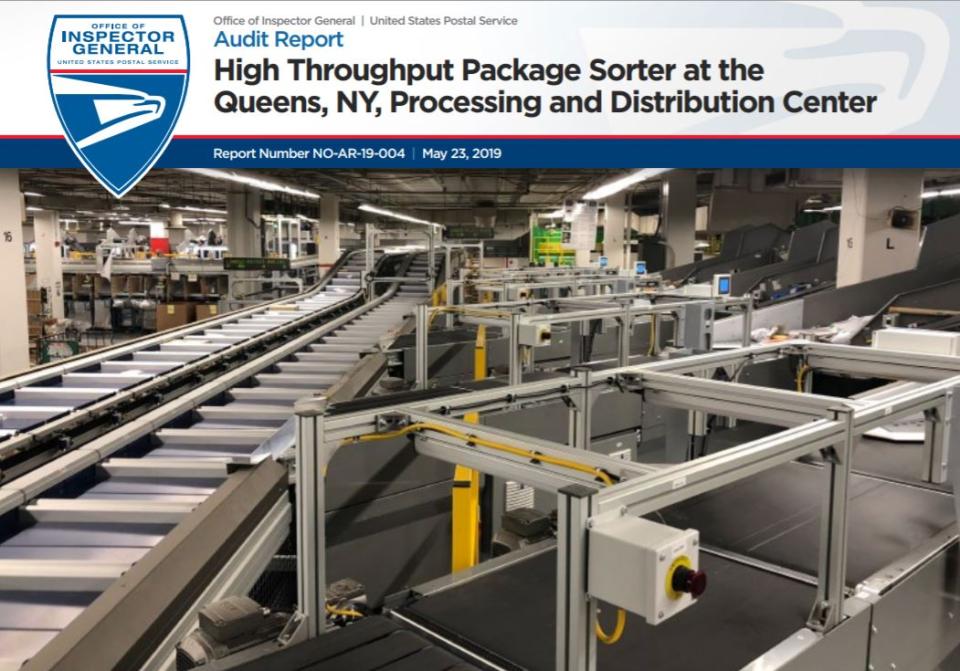High Throughput Package Sorter at the Queens, NY, Processing and Distribution Center
Objective
Our objective was to evaluate the performance and functionality of the Postal Service’s High Throughput Package Sorter (HTPS) at the Queens, NY, Processing and Distribution Center (P&DC) and determine whether planned transportation savings were realized.
In February 2017, the Postal Service approved about $32.5 million for the purchase of its second HTPS machine to assist with the rapidly expanding number of inbound international packages arriving at the John F. Kennedy International Service Center (JFK ISC). The Postal Service projected that installing the HTPS at the Queens P&DC would save transportation costs of $131.1 million for fiscal years (FY) 2018 through 2028 ($8 million for FY 2018) by eliminating trips between the JFK ISC and other facilities. The Queens HTPS became fully operational in November 2017.
The Postal Service originally projected deploying up to 30 HTPS machines at P&DCs nationwide. However, in May 2017, the Postal Service approved deployment of an Enhanced Package Processing Sorter (EPPS) which will have higher throughput and productivity than the HTPS. As a result, the Denver, CO, and Queens HTPS machines are the only two deployed and there are no plans to purchase additional HTPS machines at this time.
What the OIG Found
The HTPS machine at the Queens P&DC did not meet its performance and functionality goals and did not achieve the projected $8 million in transportation savings for FY 2018. Specifically, for the period December 2017 through November 2018, the average throughput (number of packages fed through the machine divided by hours of machine use) was 12,489 packages per hour — about 17 percent lower than the projected 15,000 packages per hour. In addition, the average calculated productivity (number of packages fed through the machine divided by employee workhours) was 374 packages per workhour — about 22 percent lower than the 478 packages per workhour goal.
The machine exceeded the 197,629 average daily packages processed goal by about 31,000 pieces (or about 16 percent) by running the HTPS at its maximum daily runtime of 18-20 hours per day in order to process all the HTPS package volumes. However, throughput and productivity are more relevant measures of HTPS performance as these measures directly affect personnel and transportation costs.
The HTPS was not meeting the throughput goal because about 17 percent of the machine’s trays were occupied with recirculating packages. When the HTPS cannot read a package address (for example when it is only partially illegible), it sends an electronic image to the Remote Encoding Center (REC) in Salt Lake City, where an employee reviews the image of the address and attempts to correct it. If correctable, the information is electronically returned to the HTPS machine and the package is sorted. If the address is not correctable, the package can circulate on the HTPS up to three times before it is rejected. This recirculation adversely affects throughput.
From December 2017 through November 2018, 83.6 million packages were fed into the Queens HTPS machine and 10.5 million packages (or about 13 percent) were rejected. When packages are rejected from the HTPS operation, they are resorted on less efficient processing equipment.
The HTPS was not meeting the productivity requirement of 478 pieces per workhour in part because 33 employees were needed to staff the machine rather than the projected 30 staff members. The additional staff were needed to open and load mail, remove non-machinable packages, and scan mail barcodes.
We also noted that employees were charging workhours to the HTPS machine operation when not working in that operation. During our site observations from November 5-8,18 of 141 Queens P&DC employees (or about 13 percent) were charging the HTPS operation number but not working in that operation. An additional 12 employees were working in the HTPS operation but were not using the HTPS operation number. When employees do not attribute workhours to the correct operation, the Postal Service cannot effectively evaluate performance and ensure adequate staffing.
We also found that the Postal Service only achieved $269,000 of the projected $8 million of transportation savings in FY 2018.
Addressing the low throughput and productivity of the HTPS at the Queens P&DC will help reduce costs, increase operational savings, and better support the Postal Service’s strategic plan to build a world-class package platform. We calculated that the lower than expected throughput cost the Postal Service about $2.1 million from December 2017 through November 2018.
What the OIG Recommended
We recommended management:
Develop a plan to reduce the number of packages recirculated or rejected by the Queens HTPS machine to achieve daily volume and throughput goals.
Instruct supervisors to review staff labor code selections for accuracy for the Queens HTPS.

